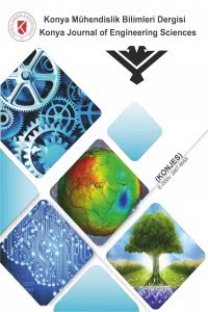Konya ili hastane atıksularının karakterizasyonu
Bu çalışmada Konya'daki üç büyük hastanenin atıksu özellikleri incelenmiştir, Atıksu örnekleri hastanelerin atıksularının şehir kanalizasyon sistemine verildiği noktalardan kompozit olarak alınmıştır. Hastane atıksularının BOI5, KOI, AKM, toplam fosfor, nitrat azotu, fenol, bakır, kurşun, çinko ve krom içerikleri ölçülmüştür. Kimyasal analizlerde CADAS-200 UV-VJS spektrofotometre ve hazır kitleri kullanılmıştır. Radyoaktivite ölçümleri bir Geiger-Mueller sayaç kullanılarak gerçekleştirilmiştir. Hastane atıksularının bakteriyolojik analizinde, membran süzme yöntemi kullanılmış ve hazır besiyerlerine ekim yapılmıştır. Çalışma sonucunda hastane atıksularmın orta ve kuvvetli karakterde değişen evsel atıksu özelliklerinde olduğu belirlenmiştir. Araştırmanın yapıldığı üç aylık dönemde önemli ölçüde radyoaktivite tespit edilmemiştir.
Characterization of hospital wastewaters of Konya
In this work composition of wastewater generated in three main hospitals in Konya-Turkey was investigated. Wastewater samples were collected from the sewerage outlet of the hospitals. Chemical and radioactivity analyses of samples were carried out in order to determine heavy metal contents and parameters of BOD5, COD, SS, nitrate nitrogen and total phosphorus. Chemical analyses were performed employing CADAS-200 UV-VIS spectrophotometer and its ready kits. Radioactivity measurements were carried out using Geiger-Mueller counter. The characteristics of hospital wastewaters were found to be changing between medium to strong strength domestic wastewater. In the period of this research only background level radioactivity was detectable.
___
- Aklan, H., Göksel, S. A., Türer, A., 1989, Türkiye'de Kullanilan Radyoaktif Maddeler ve Radyoaktif Atıklar Potansiyeli. Radyoaktif Atıklar, Çevre ve Saglık Sempozyumu Bildirileri,Boğaziçi Üniversitesi, İstanbul, 3-5 Mayis.
- Altın, A., Değirmenci, M., Altın, S., 1999, Determination of Amount and Characteristics of Hospital Wastewater in Sivas City. Dokuz Eylül Ünv. Müh. Fak. Fen ve Mühendislik Dergisi.
- Altın, A., Değirmenci, M., Altın, S., 1998, Hastane Atıksularının Arıtılması, Kayseri I. Atıksu Sempozyumu, Kayseri, 22-24 Haziran.
- Aydın, M. E., Sarı, S., 2002, Composition of Hospital Wastewaters, International Conference Environmental Problems of The Mediterranean Region, Nicosia-Northern Cyprus,April 12-15.
- Aydın, M. E., Kara, G., Sarı, S., 2002, Hastane Atıksularında Fitotoksisite, 4. GAP Mühendislik Kongresi, Şanlıurfa, 6-8 Haziran.
- Daughten, C. G., Jones-Lepp, T. L., 2001, Pharmaceuticals and Personal Care Products in the Environment: Scientific and Regulatory Issues, Symposium Series 791, American Chemical Society, Washington, D. C.
- Daughton, C. G., Ternes, T. A., 1999, Pharmaceuticals and Personal Care Products in the Environment: Agents of Subtle Change, Environmental Health Perspectives, 107 (6), 907-938.
- Halling-Sorensen, B., Nielsen, S. N., Lanzky, P. F., Ingerslev, F., Lützhoft, H. C. H., Jorgensen, S. E.,1997, Occurence, Fate and Effects of Pharmaceutical Substances in the Environment-A Review, Chemosphere, 36, 357-393.
- Hazardous Waste and Solid Waste, David H. F. Liv, Bela G. Liptak, Lewis Publishers, 2000, USA.
- Jorgensen, S. E., Halling-Sorensen B., 2000, Drugs in the Environment, Chemosphere, 40, 691-699.
- Kümmerer, K, 2001 a, Drugs in the Environment: Emission of Drogs, Diagnostic Aids and Disinfectans into Wastewater by Hospitals in Relation to Other Sources/A Review, Chemosphere,45,957-969.
- Kümmerer, K., 2001 b, Pharmaceuticals in the Environment: Source, Fate, Effects and Risks, Springer Inc., pp: 265.
- Tolosana, S., Ehrlich, R., 2000, Composition of Liquid Effluent Discharged by Medical Institutions in Cape Town, South African Journal of Science.
- ISSN: 1300-5200
- Yayın Aralığı: Yılda 4 Sayı
- Başlangıç: 2018
- Yayıncı: -
Sayıdaki Diğer Makaleler
Selma ARICAN, Mehmet BAYRAK, O. Nuri UÇAN
Konya ili hastane atıksularının karakterizasyonu
Kayadibi (Elmadağ-Ankara) serpantinitlerinin jeolojisi ve hidrotermal alterasyonları
Kentsel arayüzlerin düzenlenmesine yönelik analitik bir çerçeve
Alkan Havva BALA, TAYYİBE NUR ÇAĞLAR
Marmaris (Muğla) peridotitinin petrografik ve petrokimyasal özellikleri
Stress analysis of circular plates by the harmonic differential quadrature (HDQ) method
Ömer CİVALEK, H. Hüseyin ÇATAL
Konya ana tahliye kanalı su ve sedimentlerinde poliklorlu bifenil (PCB) bileşiklerinin belirlenmesi
MEHMET EMİN AYDIN, Sezen SARI, Senar ÖZCAN
